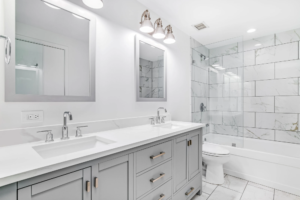Small bathroom remodel cost Safety Harbor Florida
- Bathroom Remodel, Bathroom Remodel Contractors Safety Harbor, Bathroom Remodel Costs Safety Harbor, Bathroom Remodel Reviews Safety Harbor, Bathroom Remodelers Safety Harbor, Bathroom Remodeling Services Safety Harbor, Bathroom Renovation Companies Safety Harbor, Best Bathroom Remodel Safety Harbor, Home Reno, Small Bathroom Remodel Safety Harbor
- What are the most cost-effective materials for a small bathroom remodel in Florida
- Are there any tax incentives for bathroom remodels in Florida
- What are the hidden costs to watch out for in a bathroom remodel
- How can I avoid unexpected structural repairs during a bathroom remodel
- What steps should I take if I discover mold during my bathroom remodel
The cost of remodeling a small bathroom in Safety Harbor typically ranges from $3,000 to $15,000, depending on the scope of work, materials, and labor:
- Basic Remodels: For minimal updates like painting, replacing fixtures, and installing new tiles, costs can range from $3,000 to $10,000.
- Mid-Range Remodels: Projects involving higher-quality materials or minor layout changes may cost between $10,000 and $15,000.
- High-End Remodels: Luxury upgrades with custom features or significant layout changes can exceed $15,000, especially if premium materials are used.
Factors influencing costs include bathroom size, material quality, labor rates, and whether plumbing or electrical systems are relocated.
What are the most cost-effective materials for a small bathroom remodel in Florida
For a cost-effective small bathroom remodel in Safety Harbor, Florida, here are the best materials to consider:
Flooring
- Vinyl Flooring: Durable, water-resistant, and budget-friendly, costing around $5–$10 per square foot. It mimics more expensive materials like hardwood or ceramic tiles.
- Ceramic Tiles: Affordable and versatile, priced at $8–$15 per square foot. They offer durability and a wide range of design options.
Walls and Paint
- Paint: A fresh coat of paint is a low-cost option for updating walls, with costs ranging from $56–$103 for a small bathroom.
- Tile Backsplashes: Use ceramic or porcelain tiles for accent walls or backsplashes to add style without overspending.
Fixtures
- Prefabricated Vanities: These are more affordable than custom options, with prices starting at around $736.
- Mid-Range Fixtures: Opt for mid-range sinks, toilets, and faucets that balance quality and price. For example:
- Toilets: $150–$800
- Sinks: $100–$1,000
- Faucets: $250–$1,400.
Shower and Tub
- Acrylic or Fiberglass Shower Inserts: These are cost-effective alternatives to custom tile showers, with prices starting at around $659–$2,105.
- Glass Shower Doors: Replace old shower doors with budget-friendly options costing between $480–$882.
Additional Tips
- Shop for sales or clearance deals on materials.
- Consider refinishing existing items (like cabinets) instead of replacing them.
- Use DIY methods for simple tasks like painting or installing hardware to save on labor costs.
These materials and strategies can help you achieve a stylish remodel without exceeding your budget.
Are there any tax incentives for bathroom remodels in Florida
Tax incentives for bathroom remodels in Florida are limited but may apply under specific circumstances:
1. Medically Necessary Improvements
- If the remodel is for medical purposes, such as adding handrails, widening doorways, or installing accessible showers, the costs may qualify as a medical expense deduction on your federal taxes. These expenses must be reasonable and primarily for accessibility improvements.
2. Energy-Efficient Upgrades
- Installing energy-efficient features like Energy Star-certified windows, skylights, or water heaters can qualify for federal tax credits. Under the Inflation Reduction Act, you may claim up to 30% of eligible costs for such upgrades, with annual caps on specific items (e.g., $600 for windows, $500 for doors).
3. Historic Rehabilitation Tax Credit
- If your home is a certified historic structure and the remodel meets specific federal guidelines, you could qualify for a 20% federal income tax credit on substantial rehabilitation costs.
4. Local Property Tax Exemptions
- Some Florida counties offer temporary property tax exemptions for home improvements that increase property value. Eligibility and rules vary by county, so check with your local tax assessor’s office.
Key Notes:
- Most general bathroom remodels are not tax-deductible unless they fall into the categories above.
- To claim energy-efficient credits, file IRS Form 5695 with your tax return.
What are the hidden costs to watch out for in a bathroom remodel
When planning a bathroom remodel, it’s crucial to be aware of several hidden costs that can significantly impact your budget. Here are the key hidden costs to watch out for:
- Water Damage and Mold: Discovering water damage or mold behind walls or under floors can lead to additional repair costs, ranging from $500 to $3,500 for remediation.
- Structural Issues: Uncovering problems like rotting wood or unstable framing during demolition can add thousands to your budget.
- Outdated Plumbing and Electrical Systems: Upgrading old pipes or rewiring to meet current codes can be a substantial expense.
- Permit Fees: Obtaining necessary permits can be time-consuming and costly, varying by location and project complexity.
- Failed Inspections: Rework required due to failed inspections can delay the project and increase costs.
- Specialized Labor: Tasks requiring expert skills, such as custom tile work or luxury fixture installation, often come with higher labor costs.
- Material Miscalculations: Underestimating material needs or encountering shortages can lead to increased expenses, especially for specialty items.
- Removal and Disposal Costs: Hauling away debris and old fixtures can add $100 to $500 to your budget.
- Ventilation Upgrades: Improving bathroom ventilation to prevent future mold growth may be necessary.
- Custom Fixtures and Fittings: Adjustments for custom vanities or unique tile patterns can increase labor costs.
To mitigate these risks, experts recommend:
- Conducting thorough inspections before starting the remodel.
- Allocating a contingency budget of 10-20% of the total project cost for unexpected expenses.
- Working with reputable contractors who provide detailed, transparent quotes.
By anticipating these hidden costs and planning accordingly, you can better manage your bathroom remodel budget and avoid unpleasant financial surprises.
How can I avoid unexpected structural repairs during a bathroom remodel
To avoid unexpected structural repairs during a bathroom remodel, follow these key steps:
1. Conduct a Thorough Pre-Remodel Inspection
- Hire a professional home inspector to assess the bathroom for hidden issues like water damage, mold, or structural weaknesses before starting the remodel. Look for signs such as sagging floors, cracks in walls, or damp areas that may indicate underlying problems.
2. Address Known Issues Before Remodeling
- Fix any visible damage, such as leaks, rotting wood, or mold, before beginning the remodel. Replace compromised materials like subfloors or drywall to ensure a solid foundation for the project.
3. Plan for Plumbing and Electrical Updates
- Bathrooms often have outdated plumbing or wiring that may not meet current codes. Work with licensed professionals to inspect and update these systems as needed to avoid surprises during construction.
4. Ensure Proper Ventilation
- Poor ventilation can lead to moisture buildup and mold growth over time. Install or upgrade exhaust fans and ensure adequate airflow to prevent future structural damage.
5. Work with Experienced Contractors
- Partner with reputable contractors who can identify potential risks during the planning phase and provide solutions for addressing them. Their expertise can help foresee and mitigate structural challenges.
6. Set Aside a Contingency Budget
- Allocate 10-20% of your total remodeling budget for unexpected repairs. This financial cushion will help you address any unforeseen issues without derailing your project.
7. Inspect During Demolition
- Once walls and floors are opened up during demolition, inspect for hidden damage such as termite infestations, rotted joists, or asbestos. Address these issues immediately to avoid costly repairs later.
By taking these proactive measures, you can minimize the risk of unexpected structural repairs and ensure a smoother remodeling process.
What steps should I take if I discover mold during my bathroom remodel
If you discover mold during your bathroom remodel, take the following steps:
- Stop work immediately and assess the situation. Pause your renovations to prevent spreading mold spores throughout your home.
- Determine the extent of the problem and identify the underlying moisture issue causing the mold growth.
- Consider hiring a professional:
- For large areas or if you suspect toxic black mold, contact a certified mold remediation specialist.
- An indoor environmental consultant can provide an educated assessment and advice.
- If dealing with a small area yourself:
- Set up containment using polyurethane barriers (at least 3 mil thick) to prevent cross-contamination.
- Wear proper protective equipment: safety glasses, rubber gloves, N95 respirator, and disposable suit.
- For non-porous surfaces, clean with a bleach solution or vinegar.
- Remove and dispose of porous materials (e.g., drywall, carpet) in sealed 3 mil thick trash bags.
- Address the root cause:
- Fix any leaks or moisture problems before continuing the remodel.
- Ensure proper ventilation by installing or upgrading exhaust fans.
- After remediation:
- Consider using mold-inhibiting paint or encapsulants on affected areas.
- Implement preventive measures like dehumidifiers to maintain healthy humidity levels.
- Resume your remodel only after the mold issue has been fully resolved and the area is dry.
Remember, proper mold remediation is crucial for your health and the success of your bathroom remodel. When in doubt, always consult with professionals to ensure safe and effective mold removal.

Affordable Safety Harbor Bathroom Remodeling Services for Every Budget
Affordable bathroom remodeling services in Safety Harbor can cater to various budgets by offering a range of options from minor updates to full renovations. Here

Safety Harbor Bathroom Remodel Reviews: Lessons Learned & Cost Breakdowns
Here are some key lessons learned and cost breakdowns from Safety Harbor bathroom remodel reviews: Lessons Learned Cost Breakdowns Real-Life Experiences These lessons and cost

The Benefits of Hiring Expert Bathroom Remodeling Services in Safety Harbor
Hiring expert Safety Harbor bathroom remodeling services offers numerous benefits that can transform your bathroom into a functional and aesthetically pleasing space. Here are some

DIY vs. Professional Safety Harbor Bathroom Remodel Costs
DIY bathroom remodeling in Safety Harbor typically costs $70 to $100 per square foot, while professional remodels range from $120 to $275 per square foot.

How to Find the Best Bathroom Remodel Contractors Near Safety Harbor
Finding the best bathroom remodel contractors near Safety Harbor involves several steps to ensure you hire a reliable and skilled professional. Here’s a guide to

Bathroom Remodeling Services Safety Harbor
Transforming your bathroom into a luxurious and functional space requires the expertise of top-notch remodeling services. Here are some of the best Safety Harbor bathroom

Bathroom Renovation Companies Safety Harbor
When hiring a bathroom renovation company in Safety Harbor, it’s crucial to ask the right questions to ensure you’re making an informed decision. Here are

Small bathroom remodel ideas in Safety Harbor
For a small bathroom remodel in Safety Harbor, consider these creative ideas that enhance space and style: Design Strategies Color and Texture Functional Elements Coastal

Small bathroom remodel cost Safety Harbor Florida
The cost of remodeling a small bathroom in Safety Harbor typically ranges from $3,000 to $15,000, depending on the scope of work, materials, and labor:


